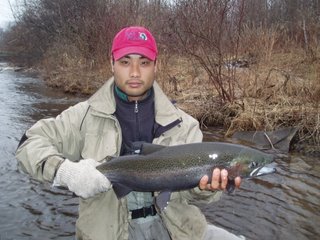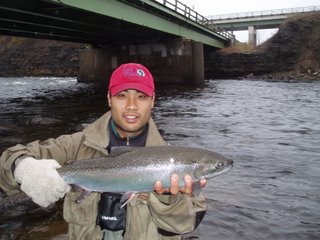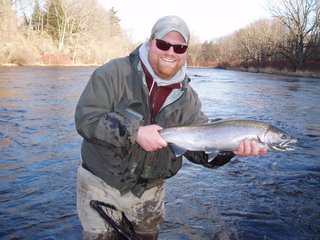
Before I was old enough to drive, and even before I had the money to buy korkers and walk out on the jetties of Indian River Inlet, I knew I loved seatrout. Back in the stone age, or, more specifically the late 80's before the populations crashed we used to take charter trips to Wachapreague, Va in the fall and catch small "spike" trout by the hundreds. These seatrout were easy, and I never saw one over 24 inches until I got older and began to explore other water. more specifically, before I discovered the Delaware seashore. It was on the North Jetty of the Indian River inlet that I caught my first seatrout on terra firma. I was still young and had no idea that these fish could be taken from shore. As time wore on I learned more about the inlet and it's trout. My fascination grew as I began to learn how to target the bigger ones.

The trips I took to Delaware started to be specifically for seatrout. Most anglers are drawn to the inlet after it's stripers, but I was (and am) spoiled when it comes to fishing for stripers, so most of my efforts were after the mysterious trout. It was always enjoyable to fish on the north jetty, I was the one guy throwing light lures on the beach side when all the tough-guy jetty-jocks flocked to the point, throwing plugs and heavy jigs with equally heavy rods, usually 50lb braid. "What you think yer gonna catch with that little rod?" was a common question posed from the striper guys. When I answered "trout", generally they'd just say "oh, them" and turn back to heaving wood and metal into the inlet
This mentality was pretty typical when I began to fish the inlet back in the mid 90's. The striper guys considered trout a lesser fish, though now it has changed since the trout have become so scarce that people who fish for trout are now regarded as diehards and dreamers: They long the days when the tiderunners were something that you caught without having to spend all night fishing light jigs for MAYBE a hit or two.

When I started the hey days were just beginning to turn into "slower" years so it was close enough to the times when fisherman could remember that so many tiderunners would choke into Delaware bay that they were considered to be pest fish. Guys used to go on headboats and fill trash cans with 10-15 pound trout, some nearly sinking their boats with them. I never got to see these days, and yes, I'm pissed off about that.
Now every year is a bit slower, and there's less and less trout just about wherever you fish. Trout over 10 pounds are about as common as unicorns, and as of this writing it's been three years since I've caught one. New Jersey still has a decent amount of fish that are highly guarded by secretive anglers. Actually, come to think of it, all trout anglers are secretive these days, to the point of being cultish. Try asking me where I fish and at what tides, you'll have to waterboard me to get a straight answer.
This is part the mystery of the the trout as they are, but as well a result of a dwindling resource, recreational fisherman are caught in a sick game of trickle-down resourcing: we get what's left after the nets get their fill. Generally, that's not much at all. You pray for a year that they miss the school, spring and summer trout travel in huge schools that are easily ransacked by netters), or you hope those spikes you were catching last year will grow this year. Sometimes the spikes come back bigger, sometimes they disappear, it's the nets. No one is going to convince me otherwise when I spend a summer catching 16 inch trout every outing and they are gone the next year.

So after that depressing interlude, let me move on to a more pleasant topic. Actually catching trout. In the inlet, you fish jigs from 1/4 to 3/4 oz. depending on tide. If you really know your stuff and know how to "ride" the currents right, you'll never have to go heavier than 3/8 oz. My friend Dae (pictured above) is probably the best jig fisherman I know, and that's basically all he fishes unless he's "trying something new" and generally, "trying something new" means going lighter (1/8 oz), rather than heavier. He also happens to be a master at fishing jigs for flounder, he's patient enough to keep things slow along the bottom where they lie, He's been known to set up near other experienced fisherman and start hooking so many fish they can't help not to ask him what he's doing. They visibly wince when they see he's fishing the same jigs they are, just more effectively.
So you're standing on rocks, looking out into black swirling waters with this relatively small jig. You don't think it's even possible to get to the fish with something that light. But when you look out into that darkness you begin to see small rips, changes in the current. As a kid it looked like a massive, feartureless canyon that All The Water In The World was flowing through. But it's not that way, and once you get over the inital feeling of awe, you see where the surface of the water flattens when it hits a dropoff, and gets wavy again when the dropoff slopes upward. It's just like a giant stream that you have to break down an analyze bit by bit. That's a common analogy made by fisherman, and it's true, even a backwoods brook trout creek can be broken down if you look at it and analyze it enough. The truths come piecemeal, and never fully are revealed, but generally you're able to figure things out enough to catch a fish or two.
You cast up current and let your jig swing and swing and swing. You only have to apply a little bit of action, just a gentle flick of the rod tip here and there. The jig will swing by you, slowly, sinking, but sometimes when the current catches it right, it will hover in the water, being pushed up and held there by an upwelling of current. At these neutral points, if you're in the right place, near the dropoffs and structure, you'll get your bite. Through all that line, maybe 20-40 feet down or more, that big arc, where your jig is probably 15 yards downstream of where your line meets the water, even though it doesn't feel like that... you get the tiniest, slightest, hair of a bite: A tiny "blip" in the night. Fisherman that are new to this kind of fishing miss the bite, those that are trying to learn set the hook constantly despite not getting bit. It's kind of like deep water nymph fishing for freshwater trout.
The "trout tap" is my favorite aspect of fishing for them. The bites are so tiny and hard to detect that, when you're in tune with them it's almost spiritual. Something goes off in your brain after casting repeatedly for far too long. and you set up on a fish. The first run of a tiderunner is a violent, headshaking, streak-of-death-back-to-the-deep that if you're fishing light line like I do, leaves you feeling completely helpless as your rod arcs violently and your drag screams in the night. The fish blasts across current and your drag makes sounds that the small stripers (an inevitable byproduct of trout fishing in the inlet) could never make. I've had this happen after 8 hours of nonstop fishing, and it pulls you out of the trance of nonstop casting like a welcome slap in the face. I get all excited and shaky, I feel like I'm 12 again and about to achieve another fishing "first", I live for this.
 The fish will come up in slow circles, always trying to stay low. Bigger trout mean more runs, which, means a greater chance of losing them. Trout are known for their soft mouths, and will tear themselves off the jig. This is the true reason why they are also called "weakfish". If you lose him, and it's a trout, you curse quietly to yourself and reel in. Under your headlamp you see the tell-tale "vampire bite", two small pin pricks resembling fangs are left in your jigs. If you get one of these after fishing for hours on end, especially if you lose the fish by making a stupid mistake you might torment yourself: thinking about how rare these fish are now, wondering how big that fish was....all you wanted was a picture, and now all that's left is to go back into that mechanistic mode of repetitive casting and sorting through small stripers. If you let it get to you too much, you'll be better off heading home. This is a mental game.
The fish will come up in slow circles, always trying to stay low. Bigger trout mean more runs, which, means a greater chance of losing them. Trout are known for their soft mouths, and will tear themselves off the jig. This is the true reason why they are also called "weakfish". If you lose him, and it's a trout, you curse quietly to yourself and reel in. Under your headlamp you see the tell-tale "vampire bite", two small pin pricks resembling fangs are left in your jigs. If you get one of these after fishing for hours on end, especially if you lose the fish by making a stupid mistake you might torment yourself: thinking about how rare these fish are now, wondering how big that fish was....all you wanted was a picture, and now all that's left is to go back into that mechanistic mode of repetitive casting and sorting through small stripers. If you let it get to you too much, you'll be better off heading home. This is a mental game.If you emerge victorious, you bring the fish to the surface, slowly, keeping the drag light and letting him run (and those runs can be long). You flick on your headlamp and are greeted by red eyes. A trout's eyes glow red under artificial light, their flanks are a mix of a lighter hue of that same red that's in their eyes. At a different angle their flanks show a beautiful yellowish, molten gold. You take pictures and release the fish, probably still shaking a bit because you just did what is becoming less and less possible. To think that there was a time when fish like this all over, and everyone could catch them without having to put themselves through the tortures of montony and sleep deprivation. For a seatrout fisherman who has never seen those days, it seems quite a bit like what Heaven ought to be like.

 Generally, the first week of March brings a change in Maryland. The rivers warm up a little from the winter and everything gets just a little bit green. The willows are the first to start as far as trees are concerned, but you notice the season more in the grass. If it had been a very cold winter, you might not notice it at all, everything will still be brown and gray. Nevertheless, changes in temperature, and the longer days will tip the scales ever-so-slightly away from winter enough to coax the first few hickory shad into running the Susquehanna river.
Generally, the first week of March brings a change in Maryland. The rivers warm up a little from the winter and everything gets just a little bit green. The willows are the first to start as far as trees are concerned, but you notice the season more in the grass. If it had been a very cold winter, you might not notice it at all, everything will still be brown and gray. Nevertheless, changes in temperature, and the longer days will tip the scales ever-so-slightly away from winter enough to coax the first few hickory shad into running the Susquehanna river.The mouth of Deer Creek, where it flows into the Susquehanna river has been widely held as the best place to catch hickory shad in the world. Invariably, that's where you'll find the first few fish (and the first few fisherman chasing them.) The fish will stage there, probably waiting for the Big School that will arrive sometime around the last few days of March to the first week of April. But what comes with numbers of fish are numbers of fisherman. Often, really great fishing can be had before the hordes of fisherman come swarming from various towns in Pennsylvania (it is in the spring that we Marylanders feel like out-of-staters on our own rivers). So I like the early bite.

You might fish for two or three hours for that many fish. On a good early day you might hook a half dozen or more in a few hours. When the masses come, you can expect to hook a shad every other cast, but again, that entails dealing with often shoulder-to-shoulder crowds and that "one guy" that messes everything up.
I'm lucky enough to know most of the regulars that fish this river. I can make a phone call and get a report with the kind of detail that a tourist fisherman would pay for. I grew up here, I paid my dues, and making good contacts with competent fisherman is part of the return on an investment that I had been making since I was old enough to drive.

This really is a great time of the year. It will often happen on one of those days, before the big crowds come that nice big pod of fish moves in. I'll have the river almost to myself, and will hook more than enough shad to convince myself that spring has finally sprung. This is the kind of feeling you get on the water that has to be experienced to be understood. You'll hook a nice hickory on the end of your drift your line goes tight, the drag will sing, and you can hear all around you the sounds of spring. Across the river the cormorants are moving in, black masses of evil birds that are here for the herring and generally mark the early river herring run. The ducks will be chasing each other around in their own version of "can I buy you a drink" -albeit a little less classy. Back at the parking lot you hear the ever present sound of the spring peepers . After a whole winter of lying low, fishing for trout, you know that the Susquehanna is finally waking up. Right now begins two months of a fishing frenzy. The Hickory shad will be running up into deer creek very soon, giving way to some of the best flyrodding imaginable. Big stripers will be cruising the flats, and the white shad (American shad to you non-Marylanders) will be up at the dam. White perch will infest the river by the beginning of May, and I'll usually dedicate a trip or two to them, (and a fish fry). No matter where I go, mid-March through mid-May I'll always wish I was in Maryland, fishing the mighty Susquehanna, my home river, and she'll be full of fish.
 Facing the prospect of not being able to wade in moving water for nearly three months a look at things to come might be in order. Back in Maryland (and a long, LONG way from Minneapolis) I fish the upper reaches of the Chesapeake bay for pre-spawn stripers. These fish stage and feed along an area called the Susquehanna flats, gorging themselves on herring they push against the shorelines and points, feeding so aggressively you can hear them above the water.
Facing the prospect of not being able to wade in moving water for nearly three months a look at things to come might be in order. Back in Maryland (and a long, LONG way from Minneapolis) I fish the upper reaches of the Chesapeake bay for pre-spawn stripers. These fish stage and feed along an area called the Susquehanna flats, gorging themselves on herring they push against the shorelines and points, feeding so aggressively you can hear them above the water.At 2:30 am, sometime in the middle of April, it will all come together. I fish before the sun comes up, and sometimes after the sun goes down, but when it comes together, the result is often a striper on the end of your line as big as a 4 year old. She will be fat and full of eggs, a perfect picture fish. Given that this is Maryland's catch and release season, I'll take a few pictures of her and send her back to do her duty.

We throw very large plugs and fish with heavy line. This is not finesse fishing, instead, it's tug-of-war combat on a grand scale. When the school moves in you might pull on 15 fish in a morning. Your hands will be chewed up from lipping them, and if you aren't careful you might wind up in the emergency room with a Bomber 17j in your hand. (I've seen this first hand, but luckily have not suffered it myself).
 We wade out of the flats at that time of the morning when you switch from a headlamp to sunglasses. Spring peepers can be heard in the woods, and the dogwoods will be blooming soon. If I'm caffineated enough I'll drive the 15 minutes over to the Susquehanna river and fish for hickory shad. But usually, if the fishing is good, it's a McDonald's breakfast, and then back to bed.
We wade out of the flats at that time of the morning when you switch from a headlamp to sunglasses. Spring peepers can be heard in the woods, and the dogwoods will be blooming soon. If I'm caffineated enough I'll drive the 15 minutes over to the Susquehanna river and fish for hickory shad. But usually, if the fishing is good, it's a McDonald's breakfast, and then back to bed.

First post in a long time, but on the same token it's been a long time since I've had any meaningful time to spend on the water and write about it. I've returned recently from 9 days on the salmon river, my set-in-stone annual pilgrimage that comes after the fall semester. The fishing was more than good. This post will be more pictures than words, which is the best kind of post anyway.
Water conditions started off higher than average at 1150 cfs, and I fished a few days at 750. The last few days of the trip the water was lowered to the fabled 500cfs which many tout as the best flow for fishing the salmon river. Not too high, not too low. -and I'll agree with that. It's been said before, and I'll say it again, water flow is the most important factor in steelheading. Other fish are probably more affected by changes in water temperature (and yes, steelhead are) but water flow will dramatically effect where the fish lie, and whether or not new fish will enter the system.



Weather as well fluctuated, when I first arrived the temps were seasonal, highs in the 30's, and lows in the 20's. Then we were hit by an arctic cold blast that dropped temps down to single digit highs, and brought on a whole new kind of cold fishing. This was probably the average temperatures that I have to deal with in Minneapolis, but when you mix those temps with cold and flowing water, the combination generally results in cold feet that tend to swing the thoughts towards death, judgement, hell, and the like.


 I usually don't to much "thinking" while I'm fishing (others would say during any other activity as well), but the freezing cold certainly does affect your abililty to simply concentrate on fishing (which, I'll admit, often requires little thought).
I usually don't to much "thinking" while I'm fishing (others would say during any other activity as well), but the freezing cold certainly does affect your abililty to simply concentrate on fishing (which, I'll admit, often requires little thought).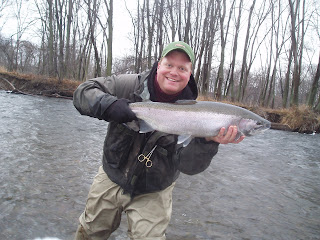


After the cold snap temperatures finally rose, so much so that I was fishing in 60 degree weather my last 2 days (and in 500cfs too!). but these temperatures lead to another consequence when the Tug Hill plateau begins to melt: runoff and rising water.

My trip started with a perfect storm of good steelheading: prior high water dropping = good fishing. rising water shuts them down, at least until they get used to it. and snowmelt completely shuts them off. I have no idea why a steelhead would shut off when the river is 33 degrees just like the meltwater, but it does, and I've seen it time and time again. It's just one of those weird "rules" that has yet to let me down. Towards the end of the trip the river rose, got colder (albeit ever so slightly), and the fish shut down. No better time to leave than when the river is high and the fish are off. Of course, for those lucky enough to have aces to this great fishery, the high water merely resets the chips, and when things stabalize, the madness begins all over again.


Sitting here and uploading the better pictures of the trip, I'm struck with the realization that trying to convey on a blog what one experiences on the water will always fall short. Right now I'm back in Minneapolis, making a blog post and refusing to pay attention in class. Fisherman probably don't make the best students, and if school were fishing, I'd have more letters after my name than words in a Russian novel. So the battle continues between future career and the immutable passion for the water. I suppose there are men with worse challenges in their lives.


Today was supposed to be too cold for the tributary I fished. It was supposed to be frozen up, or at least flowing like a coconut slurpee. That didn't happen. Weather people make mistakes, and I was able to profit from this particular one.
When the river temperatures get down to 32 degrees nature takes over, but in moving water this happens in a few different ways. There are generally 3 different types of ice a steelhead fisherman has to contend with, and none of them are enjoyable.
The most common type of ice is slush ice. This is just as it sounds, chunks of slush flowing down the river, bumping into your line, and collecting in slackwater areas. Generally slush ice will "burn off" if you get onto the river later in the morning if the sun comes out. The faster the flow of the river, the easier it is for the slush ice to burn off. As well, fishing further upstream will generally get you into clearer water earlier in the day, since the slush that forms overnight will still be floating downriver. This is a problem for me since I consider myself to be a "downriver" steelhead fisherman, tending to spend my time in chase of silver fish instead of fishing over older fish that are already battle worn and weary.
Shelf ice forms along the banks of the river and it can be very dangerous if you don't know the depth of the river that it has formed over. It's generally never stable enough to walk on, and fish like to run under it when you hook them.
Lastly, Anchor ice is ice the forms along the bottom of the river. This stuff is the worst of the worst. Generally, a good showing of anchor ice is a sign that your time might be better spent elsewhere than on the river. (Yes, and I'm aware of what I just said).
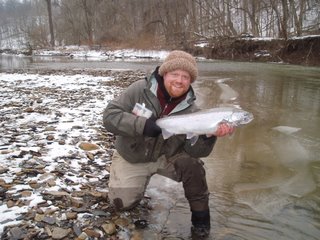
Today there was more than enough shelf ice and slush to go around. Since the weather was actually above freezing for the first time in over a week, some of the ice was breaking up and heading downstream. This is another dangerous problem, when a magic carpet of ice big enough to carry an elephant comes floating towards you threatening to cut you off at the knee. Always keep an eye upriver!
Today's fish were sluggish. I've noticed when there's a melt going on the fish tend to act funny until it's either been going on for a few days, or stops. This area I generally concentrate in faster water, but all of my fish came from slower water areas. I also experimented with cured skein today. It's gooey, drippy, nasty stuff. The fish seem to like it, and it's a lot easier than tying egg sacks. It won't be a staple for me, but it's another little tactic to keep things from getting monotonous.
well, here's a short post with some fish involved.
I took a few friends from school to the Rocky River for some frozen steelhead fishing. My one buddy Scott, who hails from Idaho would not submit to the almighty Eggsack and instead fished flies. He did well! Not that these fish can't be taken on flies, they do all the time, and I've caught them this way myself. It's just that I've gotten preoccupied with the high catch rates and ease of fishing with bait. Perhaps another lesson is in order here... Scott's fish came on a pink sucker spawn (my pattern!) which is pretty much a standby here in Ohio. There were other fish hooked and landed, but these are the best pics. It was a pretty slow day on the whole, but enough fish around to keep us occupied. The worst part of the day was finding out I had a leak in my waders a little above my knee and the water that came in slowly seeped down into my socks and froze my feet beyond what would naturally be called "cold". I believe I started to feel them a few hours after I was out of my waders and my feet were against the heater in the Jeep. Winter fishing.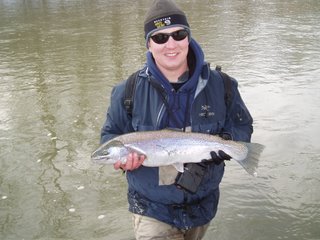

I took a few friends from school to the Rocky River for some frozen steelhead fishing. My one buddy Scott, who hails from Idaho would not submit to the almighty Eggsack and instead fished flies. He did well! Not that these fish can't be taken on flies, they do all the time, and I've caught them this way myself. It's just that I've gotten preoccupied with the high catch rates and ease of fishing with bait. Perhaps another lesson is in order here... Scott's fish came on a pink sucker spawn (my pattern!) which is pretty much a standby here in Ohio. There were other fish hooked and landed, but these are the best pics. It was a pretty slow day on the whole, but enough fish around to keep us occupied. The worst part of the day was finding out I had a leak in my waders a little above my knee and the water that came in slowly seeped down into my socks and froze my feet beyond what would naturally be called "cold". I believe I started to feel them a few hours after I was out of my waders and my feet were against the heater in the Jeep. Winter fishing.


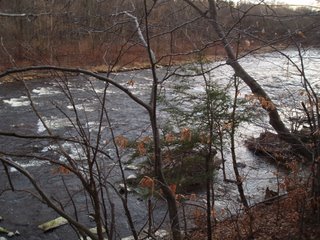
Well, things got a little crazy with the end of the semester, finals, and now with the beginning of the semester, things have only toned down a little. Such is life. I spent a about a week on the Salmon river, as is my custom for semester break, but the fishing was slow. Either that, or I've lost my touch! We did get into some fish, but it was a far different trip than last year. I was hoping to fish in snow and cold, but was met with tempatures as warm as they had been in October. This would normally be a good thing. But, water levels were low and the fish were stingy. We did manage a few hookups each day.

Lesson learned this trip: When fishing is slow and you're not hooking fish, ALWAYS check your leader after every dozen or so casts. This is elementary I know, but, I'm always pretty bad at taking my own advice. I'd certainly have better pictures than the ones I have (Big fish go bye-bye) if it weren't for this simple act that I ignored. Live and learn I suppose.
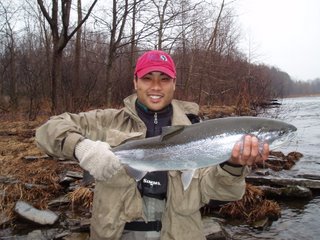
I'm in the process of planning a daytrip to Ohio, if the water EVER drops to a fishable level, so the next update might actually happen sooner rather than later. You can't fish all the time, right?
